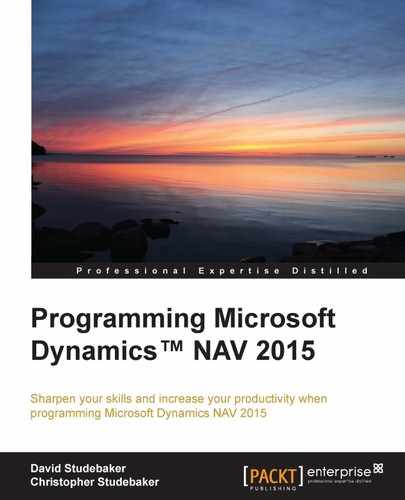Chapter 1, An Introduction to NAV 2015, starts with an overview of NAV as a business application system. This is followed by an introduction to the seven types of NAV objects, and the basics of C/AL and C/SIDE. Then we will do some hands-on work and define Tables, multiple Page types, and a Report. We'll close with a brief discussion of how backups and documentation are handled in C/SIDE.
Chapter 2, Tables, focuses on the foundation level of NAV data structure: Tables and their structures. We will cover Properties, Triggers (where C/AL resides), Field Groups, Table Relations, and SumIndexFields. We'll work our way through the hands-on creation of several tables in support of our example application. We will also review the types of tables found in the NAV applications.
Chapter 3, Data Types and Fields, we will learn about fields, the basic building blocks of the NAV data structure. We review the different Data Types in NAV. We will cover all the field properties and triggers in detail. We'll also review the three different Field Classes. We'll conclude with a discussion about the concept of filtering and how it should be considered in the database structure design.
Chapter 4, Pages – The Interactive Interface, we will review the different types of pages, their structures (Triggers, Properties) and general usage. We'll build several pages for our example application using Page Wizard and Page Designer. We will also study the different types of controls that can be used in the pages. In addition, we'll review how and where actions are added to the pages.
Chapter 5, Queries and Reports, we will learn about both Queries and Reports, two methods of extracting data for presentation to users. For Queries, we will study how they are constructed and some of the ways they are utilized. For Reports, we will walk through report data flow and the variety of different report types. We will study the two Report Designers, the C/SIDE Report Designer and the Visual Studio Report Designer and how a NAV report is constructed using both of these. We'll learn what aspects of reports use one designer and what aspects use the other. As in the previous studied objects, we will discuss Properties and Triggers. We will review how reports can be made interactive and will do some hands-on report creation.
Chapter 6, Introduction to C/SIDE and C/AL, we will learn about general Object Designer Navigation as well as the individual Designers (Table, Page, Report). We'll study C/AL code construction, syntax, variable types, expressions, operators, and functions. We will then take a closer look at some of the more frequently used built-in functions. The chapter will wrap up with an exercise on adding some C/AL code to a report objects created in an earlier exercise.
Chapter 7, Intermediate C/AL, we will dig deeper into C/AL development tools and techniques. We will review some more advanced built-in functions including those relating to dates and decimal calculations, both critical business application tools. We'll study the C/AL functions that support process flow control functions, input/output, and filtering. Then we'll do a review of methods of communication between objects. Finally, we'll apply some of what we've learned to enhance our example application.
Chapter 8, Advanced NAV Development Tools, we will review some of the more important elements of the Role Tailored User Experience, in particular the Role Center Page construction. We will dig into the components of a Role Center Page and how to build one. We'll also cover XMLports and Web Services, two of the powerful ways of connecting NAV applications to the world outside of NAV. To better understand these, we will not only review their individual component parts, but also go through the hands-on effort of building an example of each one.
Chapter 9, Successful Conclusions, we will study in detail how NAV functions are constructed and learn how to construct your own functions. We will learn more about tools and features built into C/AL and C/SIDE. We will study the new debugger, review the support for Test-Driven Development, and take a look at the ability to integrate .NET Client Add-ins. We will integrate a .NET Add-in into our example applications. Finally, we will review tips to design efficiently, update and upgrade the system with the goal of helping us to become more productive and high quality NAV developers.
Appendix, Review Answers, provides you with the answers to the questions given in each chapter.
